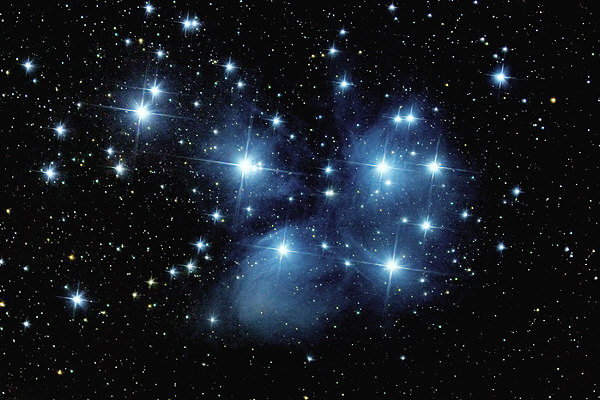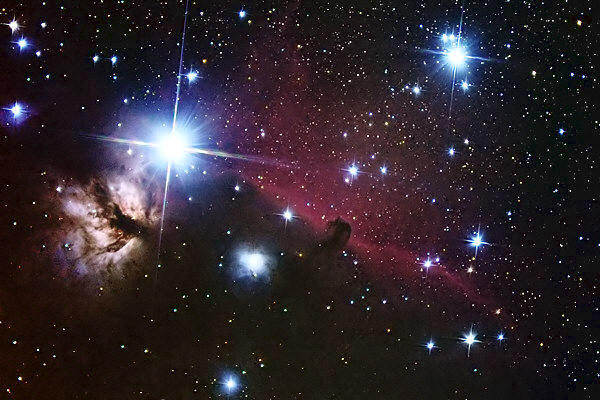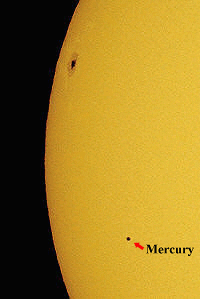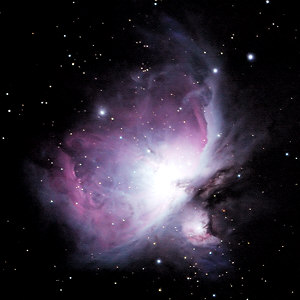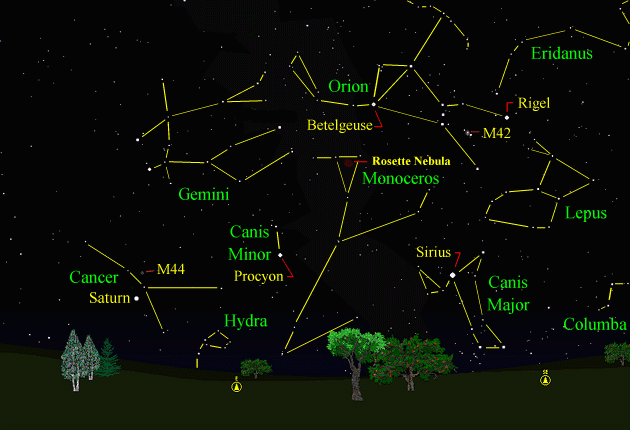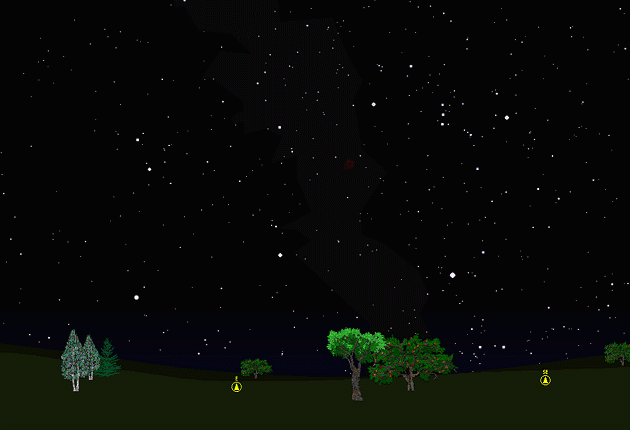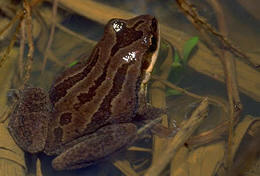The purpose of this feature is to give scout leaders, educators and naturalists an idea of some of the natural events coming up each month. We will try to cover a variety of natural events ranging from sky events to calling periods of amphibians, bird and mammal watching tips, prominent wildflowers and anything else that comes to mind. We will also note prominent constellations appearing over the eastern horizon at mid-evening each month for our area for those who would like to learn the constellations. If you have suggestions for other types of natural information you would like to see added to this calendar, let us know! Note: You can click on the hyperlinks to learn more about some of the featured items. To return to the Calendar, hit the "back" button on your browser, NOT the "back" button on the web page. All charts are available in a "printer friendly" mode, with black stars on a white background. Left clicking on each chart will take you to a printable black and white image.
Notes and Images From November 2006
The Pleiades rise early in the evening in late fall and early winter. They feature prominently in many myths and legends, and few sights are prettier than this small cluster of stars, sparkling like diamonds against a black velvet sky. The Pleiades is a true cluster of blue-white giants and sub-giants, with luminosities up to around 1000 times that of our sun. The distance to the cluster is around 400 light-years. The beautiful blue reflection nebulosity that wreathes many members of the cluster is very faint and difficult to see. The brightest part extends outward from Merope, which in the image above appears at the left bottom corner of the dipper-shaped cluster. This nebula can be seen with small telescopes in very clear, moonless skies. It was discovered with a 4" refracting telescope by W. Tempel on October 19th, 1859. Tempel described its appearance as resembling a faint stain of fog, like the effect of "a breath on a mirror."
Another sign that winter is almost here is the sight of Orion vaulting the eastern horizon. The scene to the right is the region of the bright star Zeta Orionis, also called Al Nitak. Zeta is the easternmost star in Orion's belt. It is the closest of the belt stars to the horizon as the constellation rises. At a distance is around 1600 light-years, it is a blue-white supergiant, with a luminosity around 35,000 times that of our sun. This tremendous outpouring of energy causes much of the hydrogen in its vicinity to fluoresce in the red wavelength of hydrogen-alpha light. Nebulae that fluoresce like this, like NGC 2024 below and to the left of Zeta, are called emission nebulae. Also seen in the above image are several bluish "reflection" nebulae, which shine by reflected light. Finally, one of the most famous "dark" nebulae, the Horsehead Nebula, is silhouetted by the hydrogen alpha light to the lower right of Zeta. The Horsehead Nebula is considered one of the most challenging deep sky objects to view visually. This scene not only juxtaposes the very bright and the very dark, but also illustrates extremes in temperature. Surface temperatures of blue supergiants like Zeta can reach 25,000 degrees Kelvin (about 45,000 degrees Fahrenheit.) Temperatures in dark nebulae like the Horsehead hover around 10 degrees Kelvin, or only about 10 centigrade degrees above absolute zero (minus 460 degrees Fahrenheit.)
Mercury transited the face of the sun on November 8th. The weather had been cloudy for several days before the transit and I had just about given up on seeing it. Then, about an hour before the transit was to occur, the sky started clearing and I scrambled to get the telescope set up in time to get a shot. Then, after I got a few images, I had to rush to put everything away and get ready for a program that evening. Transits of Mercury, though not as rare as transits of Venus, do not happen very often and I was happy to get a chance to see the event. The next transit of Mercury will not occur until 2016.
Sky Events for December 2006: The Geminid Meteor Shower peaks on the evening of December 13th and the morning of December 14th. The meteors will appear to radiate from a point near Castor and Pollux, in Gemini. You should be able to see the most meteors when Gemini is overhead, a little after midnight. Dress warmly (sleeping bags and lounge chairs are nice.) Winter for the northern hemisphere officially begins on the winter solstice, December 21st at 6:22 pm CST. Evening Sky: Saturn rises around 9:15pm CST at mid-month. Look for Venus to emerge from the solar glare into the western sky at dusk in late December. Morning Sky: Mercury, Mars and Jupiter should form a pretty grouping in the dawn sky from December 7th through the 14th. All three planets are within a 2 degree circle from the 9th to the 11th, and are within a 1 degree circle on the 10th. Look for the grouping in the east-southeast about 45 minutes before sunrise. This is a good chance to see the relative apparent motion of the three planets. All times noted in the Sky Events are for Franklin, Tennessee and are Central Standard Time. These times should be pretty close anywhere in the mid-state area. Constellations: The views below show the sky looking east at 9:00pm CST on December 15th. The first view shows the sky with the constellations outlined and names depicted. Star and planet names are in yellow. Constellation names are in green. The second view shows the same scene without labels.
Compare the bright stars Betelgeuse and Rigel in Orion. Betelgeuse is a red giant and the star Rigel is a very hot, very bright supergiant. Compare the color of the two stars. If you have a telescope, point it to the center of the three "sword" stars below Orion's belt. There you will find the Orion Nebula, M42, one of the most magnificent emission nebulas in the sky. It appears as a small greenish glow in small telescopes. Crouching beneath the feet of Orion, is Lepus, the Hare. Below Lepus is Columba, the Dove. Sirius, the brightest star in the sky, shines below Orion. Sirius is in Canis Major, the Great Dog, and for that reason is known as the Dog Star. In the late summer, Sirius rises at the same time as the sun. Because of this, the late summer days are known as “the dog days." The faint constellation Monoceros, the Unicorn, follows Orion over the eastern horizon. Low in the eastern sky below Gemini is Canis Minor, with its bright star Procyon. Procyon means, "before the dog," and refers to the fact that Procyon rises just before the Dog Star, Sirus. Look below Gemini and see if you can spot the faint glow of M44, the "Beehive Cluster." This cluster is located in Cancer, the Crab. Finally, Hydra, the Water Serpent, rears its head just above the eastern horizon.
On Learning the Constellations: We advise learning a few constellations each month, and then following them through the seasons. Once you associate a particular constellation coming over the eastern horizon at a certain time of year, you may start thinking about it like an old friend, looking forward to its arrival each season. The stars in the evening scene above, for instance, will always be in the same place relative to the horizon at the same time and date each December. Of course, the planets do move slowly through the constellations, but with practice you will learn to identify them from their appearance. In particular, learn the brightest stars (like Sirius and Procyon in the above scene), for they will guide you to the fainter stars. Once you can locate the more prominent constellations, you can "branch out" to other constellations around them. It may take you a little while to get a sense of scale, to translate what you see on the computer screen or what you see on the page of a book to what you see in the sky. Look for patterns, like the three stars in a line in Orion's belt. The earth's rotation causes the constellations to appear to move across the sky just as the sun and the moon appear to do. If you go outside earlier than the time shown on the charts, the constellations will be lower to the eastern horizon. If you observe later, they will have climbed higher. As each season progresses, the earth's motion around the sun causes the constellations to appear a little farther towards the west each night for any given time of night. If you want to see where the constellations in the above figures will be on January 15th at 9:00pm CST, you can stay up till 11:00pm CST on the December 15th and get a preview. The westward motion of the constellations is equivalent to two hours per month. For instance, if you want to see what stars will be on your eastern horizon on March 15th at 9:00pm CST (3 months later), you would need to get up at 3:00am CST in the morning on December 15th (3 months times 2 hours/month = 6 hours).
Sky Publishing has just come out with a beautiful and compact star atlas, Sky & Telescope's Pocket Star Atlas. It is destined to become a classic, and is a joy to use at the telescope. A good book to learn the constellations is H. A. Rey's
classic,
The Stars, A New Way to See Them. Rey's depictions of the
constellations and witty commentary are terrific. A good general reference book on astronomy is the Peterson
Field Guide,
A Field Guide to the Stars and Planets, by Pasachoff.
The book retails for around $14.00. A good beginners software program for learning the night sky
is the Starry Night Beginner program. Visit the Starry Night web site at
www.starrynight.com The program retails for around $30.00 and
contains a wealth of information.
Amphibians:
December really marks the beginning of the breeding season for our Tennessee frogs and toads. We have had breeding choruses of Southeastern Chorus Frogs as early as December 4th. Breeding even before Wood Frogs, these irrepressible inhabitants of flooded winter fields and other wet areas will call throughout the cold winter months. Listen for their call, which sounds like someone dragging their thumb across the teeth of a plastic comb, on mild wet winter evenings. Listen also for Southern Leopard Frogs. We hear them throughout the fall. Many other Tennessee frogs and toads can also be seen on mild December nights, but most are silent.
Birds: If you walk grassy fields that have some wetter areas, you may flush a Short-Eared Owl, a winter resident in Tennessee. We have flushed them from fields at Pardue’s Pond near Ashland City, along the roads that go to Pace Point near Big Sandy, Tennessee, at Britton Ford near Dover, Tennessee and at Savannah Bottoms, south of Savannah, Tennessee. These birds tend to occupy the same habitat as Northern Harriers, so if you see Harriers over grassy fields, be on the lookout for the owls. They often begin flying in the late afternoon, coursing over the fields like a Harrier. It’s a good idea to check any “Northern Harrier” you see in the late afternoon to make sure it’s not a Short-eared Owl. Through the end of December, listen for the courtship dueting of Great Horned Owls at dusk and dawn. You probably have already put out your bird feeders, but if you haven’t you're missing out on a lot of good looks at winter feeder birds. This is a great time of year to start learning your birds. Watch and listen for winter residents such as White-throated and White-crowned Sparrows, Yellow-bellied Sapsuckers, Red-breasted Nuthatches, Golden-crowned Kinglets and Brown Creepers. Recommended: Bird Finding in Tennessee, Michael Lee Bierly. A classic guide to finding birds in Tennessee. The Sibley Guide to Birds, David Allen Sibley The Sibley Guide to Birds of Eastern North America, David Allen Sibley This new Sibley Guide covers only eastern North America, is quite compact, and is less expensive than the larger Sibley. An inexpensive guide for beginners is the Golden Guide for Birds.
Archives (Remember to use the back button on your browser, NOT the back button on the web page!) Natural Calendar November 2006 Natural Calendar September 2006 Natural Calendar February 2006
Natural Calendar December 2005
Natural Calendar November 2005
Natural Calendar September 2005
Natural Calendar February 2005
Natural Calendar December 2004
Natural Calendar November 2004
Natural Calendar September 2004
Natural Calendar February 2004
Natural Calendar December 2003
Natural Calendar November 2003
Natural Calendar September 2003 Natural Calendar February 2003 Natural Calendar December 2002 Natural Calendar November 2002 Nature Notes Archives: Nature Notes was a page we published in 2001 and 2002 containing our observations about everything from the northern lights display of November 2001 to frog and salamander egg masses. Night scenes prepared with Starry Night Pro software All images and recordings © 2006 Leaps
|
